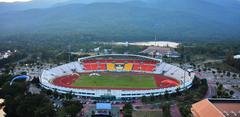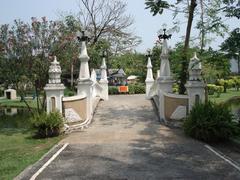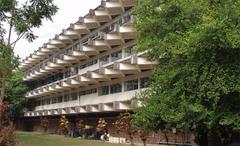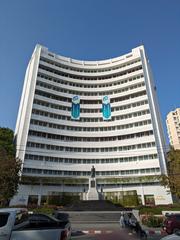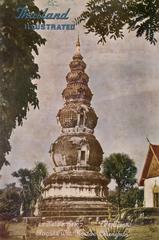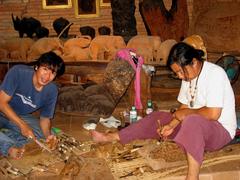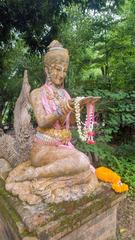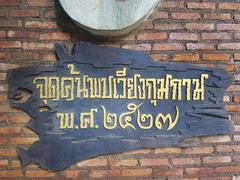Wat Ket Karam Chiang Mai: Visiting Hours, Tickets, and Historical Significance
Date: 03/07/2025
Introduction
Wat Ket Karam, nestled along the tranquil banks of Chiang Mai’s Ping River, stands as a remarkable testament to the region’s Lanna heritage and multicultural history. This comprehensive guide explores the temple’s origins, architectural highlights, religious significance, practical visitor information, and its ongoing role as a cultural hub. Whether you are a history enthusiast, spiritual seeker, or cultural explorer, Wat Ket Karam promises a layered and enriching experience in the heart of Northern Thailand (Chiang Mai Explorer; Guide2Thailand).
Historical Context and Origins
Founded in 1428 CE during the Lanna Kingdom’s golden era, Wat Ket Karam is one of Chiang Mai’s oldest and most significant temples. It was originally known as “Wat Sa Ket” (“hair wash”), referencing a sacred pond used in royal purification rituals each April 15th. The temple’s strategic riverside location made it both a spiritual center and a hub for trade, attracting Thai, Chinese, Burmese, Indian, and Pakistani merchants and settlers. This multicultural foundation is still reflected in the surrounding Wat Ket neighborhood (My Chiang Mai Tour).
Architectural and Artistic Heritage
Lanna Influences and Temple Layout
Wat Ket Karam exemplifies classic Lanna architecture with its multi-tiered, steeply pitched roofs, ornate chofah finials, and exquisitely carved teak wood elements. The temple complex is organized around a main viharn (assembly hall), a grand chedi (stupa), monks’ quarters, and auxiliary buildings. The lush riverside grounds are enhanced by shaded walkways, tropical gardens, and scenic views of the Ping River (Travelbix; Lonely Planet).
Notable Structures
- Main Viharn: The heart of the temple, adorned with gold leaf, colorful glass mosaics, and massive teak pillars. Intricate naga (serpent) motifs and floral carvings highlight the Lanna artisans’ skill (Travel Authentic Asia).
- Chedi (Ket Kaew Chura Manee): A classic bell-shaped stupa enshrining sacred Buddha relics, particularly venerated by those born in the Year of the Dog (Wikipedia).
- Monks’ Quarters (Kuti): Elegant wooden structures on raised platforms, reflecting traditional Lanna residential architecture.
- Auxiliary Shrines and Bell Tower: Smaller shrines dedicated to local spirits and Buddhist deities, alongside a traditional bell tower.
Artistic Features
- Murals: Vivid paintings inside the viharn depict scenes from the Buddha’s life, Jataka tales, and local legends, blending Lanna and Burmese influences.
- Sculptures: Guardian lions (singha), naga balustrades, and a notable Green Jade Guanyin statue representing Chinese Buddhist traditions.
- Decorative Woodwork: Doors, windows, and eaves intricately carved with lotus flowers and celestial motifs, showcasing exceptional local craftsmanship (Travelbix).
Religious Significance and Living Traditions
Wat Ket Karam remains an active center for Buddhist practice and community life. The temple hosts regular ceremonies, meditation sessions, and merit-making events. During major festivals such as Visakha Bucha Day and Loy Krathong, the temple becomes a focal point for spiritual devotion, traditional music, dance, and lantern releases—offering visitors an immersive cultural experience (Chiang Mai Explorer).
Central to its spiritual identity is the “Phra Boromthat Chedi Ketkaew Chulamanee,” believed to bestow blessings and protection, especially for those born in the Year of the Dog. The temple’s riverside location also symbolizes the harmony between spiritual and material well-being, a theme that runs through its history and community rituals (My Chiang Mai Tour).
Museum and Multicultural Legacy
The on-site Wat Ket Museum, housed in the former abbot’s residence, displays a unique collection of artifacts, photographs, manuscripts, and memorabilia donated by local families. The exhibits trace the temple’s evolution and the neighborhood’s diverse cultural makeup—showcasing the influence of Chinese traders, Western missionaries, and Thai locals (Rolling East; Chang Puak Magazine).
Visiting Hours, Tickets, and Accessibility
- Temple Hours: Daily from 6:00 AM to 6:00 PM.
- Museum Hours: 9:00 AM to 4:00 PM (closed Sundays); a nominal fee of 20–30 THB applies for museum entry (My Chiang Mai Tour).
- Admission: Entry to temple grounds is free; donations appreciated.
- Dress Code: Modest attire required (cover shoulders and knees; no shorts or sleeveless tops); remove shoes before entering temple buildings.
- Accessibility: Most temple areas are wheelchair accessible, though some museum spaces may have steps. Contact in advance for special arrangements.
- Photography: Permitted in most areas, but respect signage and avoid flash or intrusive behavior, especially during ceremonies.
Facilities and Amenities
- Restrooms and shaded seating areas available.
- Well-maintained gardens and paved walkways.
- Nearby cafes, restaurants, and artisan shops along Charoenrat Road in restored colonial buildings—ideal for refreshments and souvenirs.
Best Times to Visit
- Cool Season (November–February): Pleasant temperatures (20–28°C), fewer crowds, and vibrant festival activities.
- Early Mornings: Serene atmosphere, ideal for contemplation and photography.
- Festivals: Loy Krathong and Visakha Bucha transform the temple with decorations, music, and ceremonies.
- Rainy Season (June–October): Lush gardens and atmospheric riverside views, though expect occasional showers.
Neighborhood and Nearby Attractions
Wat Ket Karam is at the heart of the historic Wat Ket neighborhood, renowned for its multicultural heritage. Explore:
- Wat Ket Museum: Deep dive into local history and community life.
- Sri Guru Singh Sabha Sikh Temple: A symbol of interfaith harmony, established in 1905.
- Charoenrat Road: Boutique guesthouses, street art, artisan shops, and riverside cafes.
- Chiang Mai Night Bazaar and Iron Bridge: Nearby attractions for a full day’s itinerary (Rolling East).
Cultural Insights and Etiquette
- Offer alms to monks in the morning for a local experience.
- Participate respectfully in temple rituals; quiet observation is welcomed.
- Avoid public displays of affection and pointing feet at Buddha images or monks.
- Remove hats and footwear before entering sacred spaces.
Safety and Practical Tips
- The temple and neighborhood are safe, but remain aware of belongings during festivals.
- Bring water, sunscreen, and insect repellent (especially near the river).
- Wear comfortable walking shoes for the expansive grounds.
Frequently Asked Questions (FAQ)
What are Wat Ket Karam’s visiting hours?
Daily from 6:00 AM to 6:00 PM.
Is there an entrance fee?
Temple entry is free; the museum charges 20–30 THB.
Are guided tours available?
Occasionally, through local operators or by arrangement with temple staff.
Is the temple accessible for those with mobility issues?
Most areas are accessible; contact ahead for specific needs.
How do I get there from Chiang Mai Old City?
Accessible by tuk-tuk, songthaew, private taxi, bicycle, or walking via Nawarat Bridge.
Is photography allowed?
Yes, but respect signage and avoid flash in sacred spaces.
Visual Suggestions
Include high-resolution images of the grand chedi, Lanna woodwork, riverside views, and community scenes. Use alt tags like “Wat Ket Karam visiting hours grand chedi” and “Lanna architecture at Wat Ket Karam”. Consider embedding a map and virtual tour link for planning.
Explore More
For extended guides on Chiang Mai’s top temples, Lanna architecture, and cultural festivals, see our related articles. Download the Audiala app for personalized travel recommendations and real-time updates. Follow us on social media for the latest news and exclusive content.
Conclusion
Wat Ket Karam stands as a beacon of Chiang Mai’s historical, spiritual, and multicultural identity. With its origins rooted in the Lanna Kingdom, exquisite architecture, sacred relics, and ongoing community role, this riverside temple offers an unmissable gateway to Northern Thailand’s living heritage. Use this guide to plan your visit, deepen your cultural understanding, and experience the timeless beauty of Wat Ket Karam.
Sources and Official Links for Wat Ket Karam
- Chiang Mai Explorer
- Chiang Mai Travel Hub
- Travelbix
- Travel Authentic Asia
- Guide2Thailand
- My Chiang Mai Tour
- Wikipedia
- Rolling East
- Chang Puak Magazine
